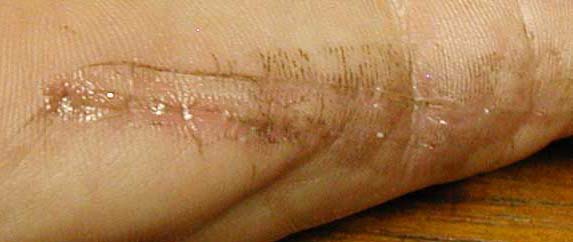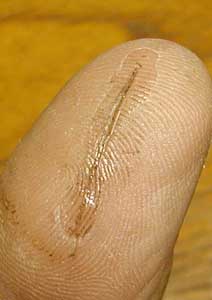
Dealing with cuts
We are not as tough as our professional sailing forebearers and here is an example. Cuts and abrasions are part of sailing, always have been. Did you worry that your hand with the nasty cut would hurt when you got salt on it in 1805? I doubt it. You would have been a pansy, or whatever the appropriate pejorative was then. Nevertheless, we have learned to try to avoid even minor pain.
This is one story in the search for relief from the pain of getting saltwater in a cut. On a trip to Santa Cruz Island in 2001, I was privileged to dive into what is known around here as Emerald Cave. This underwater cave traps a decent bubble of air so you can free-dive from another sea cave and breathe once inside. The water in a long submerged passage to the sea filters daylight to a soft emerald green glow. Really quite pretty.
 Emerald Cave is also known as Blood Cave because its
surfaces are just a little less sharp and jagged than broken glass.
Someone gets bloodied every trip. Not wearing gloves, I got several fairly
serious cuts on my hands. Bad enough to gape a little but not bad enough
to require stitches. Way past scratches, though. Serious cuts create
discomfort for a person who spends time in salt water exposures, like on a
sailing cruise. Wearing sailing gloves is like applying a salt
poultice to the wound. I tried several remedies
with varying degrees of success. Home now, I think I have found a
satisfactory solution, although I am not going to intentionally slice
myself to prove it's perfect. First I greased my hands with antibiotic
cream and put on vinyl gloves. This is not a terrible solution,
particularly if the cuts look a little infected. With sailing gloves over
the vinyl gloves, its passable. But your hands sweat and you have to take
the gloves off periodically to dry out. The gloves tear open at the
fingers too and getting sea water inside defeats the purpose.
Emerald Cave is also known as Blood Cave because its
surfaces are just a little less sharp and jagged than broken glass.
Someone gets bloodied every trip. Not wearing gloves, I got several fairly
serious cuts on my hands. Bad enough to gape a little but not bad enough
to require stitches. Way past scratches, though. Serious cuts create
discomfort for a person who spends time in salt water exposures, like on a
sailing cruise. Wearing sailing gloves is like applying a salt
poultice to the wound. I tried several remedies
with varying degrees of success. Home now, I think I have found a
satisfactory solution, although I am not going to intentionally slice
myself to prove it's perfect. First I greased my hands with antibiotic
cream and put on vinyl gloves. This is not a terrible solution,
particularly if the cuts look a little infected. With sailing gloves over
the vinyl gloves, its passable. But your hands sweat and you have to take
the gloves off periodically to dry out. The gloves tear open at the
fingers too and getting sea water inside defeats the purpose.
Next I tried Advanced Healing adhesive Band-Aids. If your injury is in a place where the bandages will stay attached, they work very well. They act like an artificial, waterproof scab. Taping the edges helps keep them in place longer. After a few days, presto, your cut is healed. On the palm of your hand, with all the flexing and abrasion, they don't last a day. Wearing vinyl gloves over them helps a little, but not much. !/weblog/images/31.jpg!
I am a great fan of super glue (cyanoacrylate adhesives), particularly the industrial-strength stuff that has to be refrigerated. Usually the problem with your hands is that you glue them to something inappropriate. Gluing the edges of a cut together is another matter. After I got home, with my cuts still not completely healed, I found a Band-Aid cyanoacrylate bandage kit on the pharmacy shelf. It seems like pretty good stuff, particularly after being reinforced with a second coat of industrial cyanoacrylate. It is waterproof. I'm a little worried that its supposed to be removable with mineral oil, but we'll see how it works out. Don't want your cuts opening up if you get diesel or lube on them. Maybe the Band-Aid product is overkill and one should go directly to the good stuff, but I want to research cyanoacrylate toxicity a little before I try it on a big wound. PS: With a little more experience, it seems that keeping the cyanoacrylate layer thin works best. If you really pile it on, it doesn't bend with the skin and tends to start peeling off. © Electric Marine, September 5, 2002
© Electric Marine, September 5, 2002